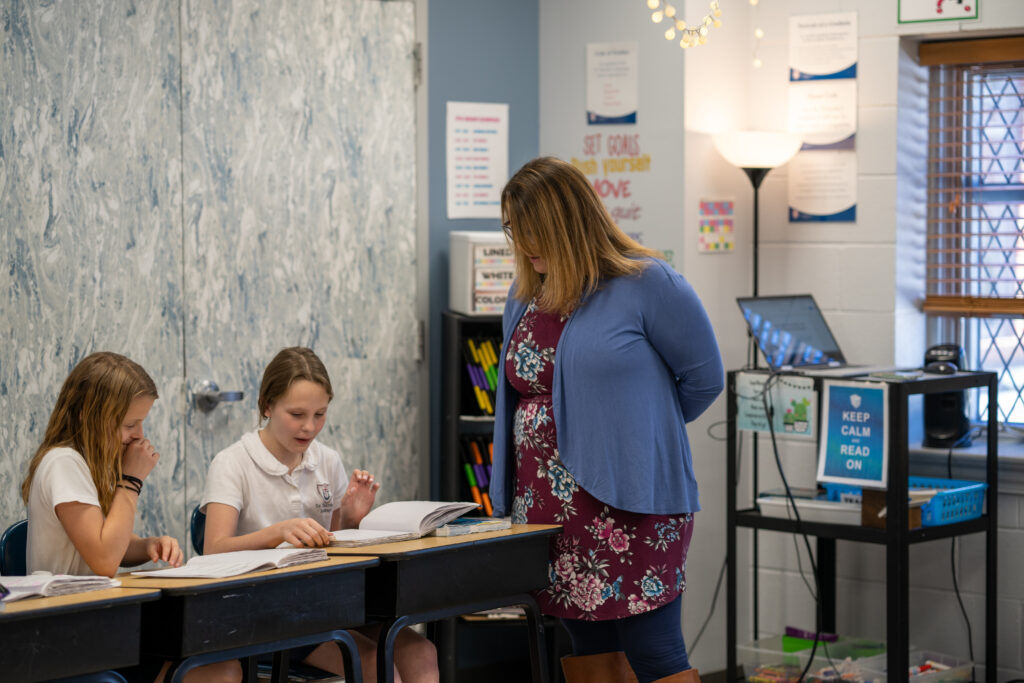One of the many advantages of our small private school is the personalized, individual attention that St. Timothy’s provides through a low student-teacher ratio. With an entire student body under 600 students in pre-Kindergarten through eighth grade, our class sizes are small enough that students receive an education tailored to their unique needs. Below are some of the benefits of a low student-teacher ratio in classrooms.
Teachers Meet Students’ Individual Needs
With smaller class sizes, teachers provide customized instruction that acknowledges and accommodates each student’s learning style. The ideal teacher-student ratio allows teachers to understand where the class stands as a whole, as well as recognize how best to implement individualized strategies.
With a lower student-teacher ratio, students enjoy more one-on-one time with the teacher, which is beneficial for a child’s academic progress. The teacher can provide more feedback and focus on the strengths of each student.
Students and Teachers Have More Time
With a large class, it’s easy for students to become distracted. Teachers try their best to reach everyone, but they may lack the bandwidth to make time for each student in a larger setting. With a lower student-teacher ratio, everyone is supported and able to address individual needs.
In a smaller class, students are more likely to do their homework, study, and listen to the lesson because the teacher is able to engage each learner. Teachers have time to attend to each student individually and make sure they understand the information. With fewer children and more attentiveness, there likely won’t be many behavioral issues that distract from learning. Overall, the environment of a smaller classroom fosters a peaceful, focused, and nurturing learning space.
Everyone Forms Stronger Relationships
Another benefit to a low student-teacher ratio is the formation of strong relationships. With individual attention from the teacher, students are more likely to feel comfortable asking questions and creating a bond. Additionally, students will get to know each other better as they consistently work with the same students in small groups.
Parents and teachers also develop close relationships. In a large classroom, teachers cannot get to know every parent personally, even if they make a solid effort to communicate. It’s easier to discuss class matters and share a child’s progress if there are fewer parents to update. Open communication between parents and teachers is essential to helping a student grow.
Students Gain Confidence and Social Skills
With a smaller student-teacher ratio, more students get a chance to speak up. It instills confidence when a student answers a question correctly or wants to share their ideas. Shy students significantly benefit from working in small groups. Large classes can be overwhelming for children, whereas some students tend to warm up more quickly when speaking to only a few people.
A tight-knit classroom also helps students get to know each other socially and maintain lifelong friendships. Schools with a low student-teacher ratio like St. Timothy’s can better encourage kindness and social skills that allow every student to feel comfortable making friendships that last.
There’s a Strong Sense of Community
In addition to the tighter personal relationships we mentioned above, there’s a strong sense of community in smaller private schools due to the low student-teacher ratio. As children move up in grades, they continue to use their past teachers as resources. Their younger peers have the same teachers, meaning everyone is familiar and able to lean on each other.
With chapel services and other activities open to all students, we at St. Timothy’s pride ourselves on our commitment to the community. Are you interested in learning more about our small student-teacher ratio and class structure? Reach out and get to know St. Timothy’s today!


